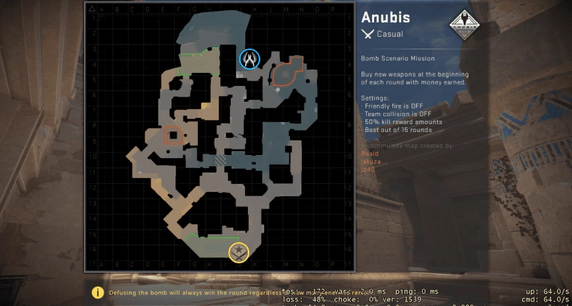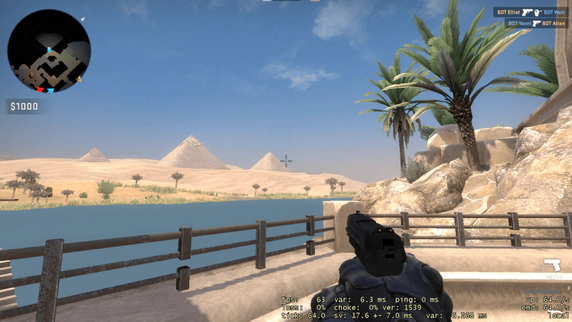What You Need To Know About Anubis Callouts
Table of Contents
From time to time the developers of the iconic game Counter-Strike: Global Offensive add new maps to the Map Pool. The latest location that became available to professional players is Anubis. Already from the name it becomes clear that the map is Egyptian themed. Many experts were afraid that the large size of the territory would not be suitable for the game at a high level. However, some updates and improvements made the location acceptable for both matchmaking and professional arenas.

Anubis Callouts are necessary for users to tell teammates where their opponents are as quickly as possible. Given that the map has only recently been created, there are already a lot of names for positions that haven’t been used before. Accordingly, the gamer can achieve results and show their maximum level of individual skills.
Considering that many of the names are similar to Dust2 Callouts, we can assume that a player who has shown normal play on Anubis will be quite good on this location as well.
Basic Anubis Callouts

There are already about 30 names for the main positions on this map. Among the actual Anubis CS:GO callouts llp worth mentioning:
- T Spawn, CT Spawn. These are the areas where the teams start each round. It should be noted that this area is not heavily isolated, and therefore the user in the course of the game may be there several more times.
- A Site, B Site. These are the points for laying the bomb. A Site is located in close proximity to CT Spawn, while B Site is located in the central part of the map.
- Heaven. The area that connects CT Spawn and A Site. In fact, you can get from one point to the other in 7–8 seconds. Therefore, one or two defenders are sent to control this zone at the beginning of the round.
- Fountain. This is the point through which the Terrorists get to A Site. It’s in this position that they very rarely encounter their enemies.
- Back Site. Among Anubis Map Callouts, it’s worth noting these points. In fact, this is the place where Counter-Terrorists can unexpectedly meet the enemy and fight back.
- A Main. An area located in close proximity to A Site. Terrorists won’t necessarily pass through if they plan to mine the area.
- Boat. From the name, it is clear that this is the point associated with the boat, located in the central part of the location. The name is seldom used by players, but should be known.
- Water. You will often encounter opponents in this area, as there are several approaches to this point. For example, you can get to B Site through Water, or you can watch what’s happening on the bridge above.
- Bridge. This point is used by Terrorists to get to the central part of the map.
- B-Con. An area connecting Water and B Site. This position plays a central role in Anubis CS:GO. It is used directly in a number of strategies.
- Ruins**. The point of approach to B Site from the T-Spawn side. From the name it is clear that here the user will see a lot of destruction and relics of ancient Egypt. Counter-Terrorists also try to occupy this area, because killing one or two opponents can win the whole round.
- B Main. This is a relatively small position that connects Ruins and B Site. If an attacking player ends up here, the probability of encountering an enemy is extremely high.
- Ninja and Back Site. Hidden positions that are located in B Site. If you play as a Terrorist and find yourself in a bomb zone, then these positions should be checked first.
- Corner. Another position located in B Site. Probably a good place to meet enemies with an MP7, or MP9.
- Street. Approach to B Site. This is a fairly long position, allowing players to view enemy movement.
- Sniper. The area between Street and CT Spawn. From the name coined by the users, it can be understood that this point is most often occupied by AWP and Scout fighters. This is due to the fact that the view allows you to kill the enemy in the head. However, the Terrorists have already found the arguments and with the help of grenades they don’t let their opponents take the position.
- Cave. Point which in CS:GO Anubis connects Street and CT Spawn. Players are often faced with the choice of which way to choose.
- Palace. An enclosed space where you can reload weapons and rest a few seconds before the next attack. Users in Matchmaking rarely use Palace, so you can take your opponent by surprise.
- Mid. The central part of the map. It is from this position that the player has a path to both bomb points, as well as the main positions. You can’t go out here without using grenades. The fact is that surviving in this situation is virtually unrealistic if the opponent is an experienced user.
- Heaven. Located in close proximity to CT Spawn. Accordingly, players who move towards A Spawn will definitely pass through Heaven. Of course, this position is different from the one available in Nuke, for example, since there is no sublimity here.
In general, this is a non-standard map which you should get used to. Although it visually reminds players of Dust2, its structure is much more complex. Accordingly, players in this location are open to using strategies and are more mobile.
If a player seriously wants to learn how to play all the maps in Map Pool, it is important to devote a lot of time to tactical information. Communications will help you spread the word as quickly as possible. Ancient Callouts are something new for many users. The green location, which outwardly resembles Aztec, is in demand and relevant. However, the difficulty in understanding the nuances can bring problems.

